Wind blows through your hair while sun rays warm up your skin. Your favorite music streams from your car’s speaker boxes. Open views of the Shenandoah Valley or the Virginia Piedmont alternate with dense forest scenery.
As you zoom past yet another spectacular viewpoint, a deer scurries back into the brush. If you’re lucky while driving Skyline Drive, you might even spot one of Shenandoah National Park’s hundreds of black bears hanging out in a tree or foraging on the roadside.
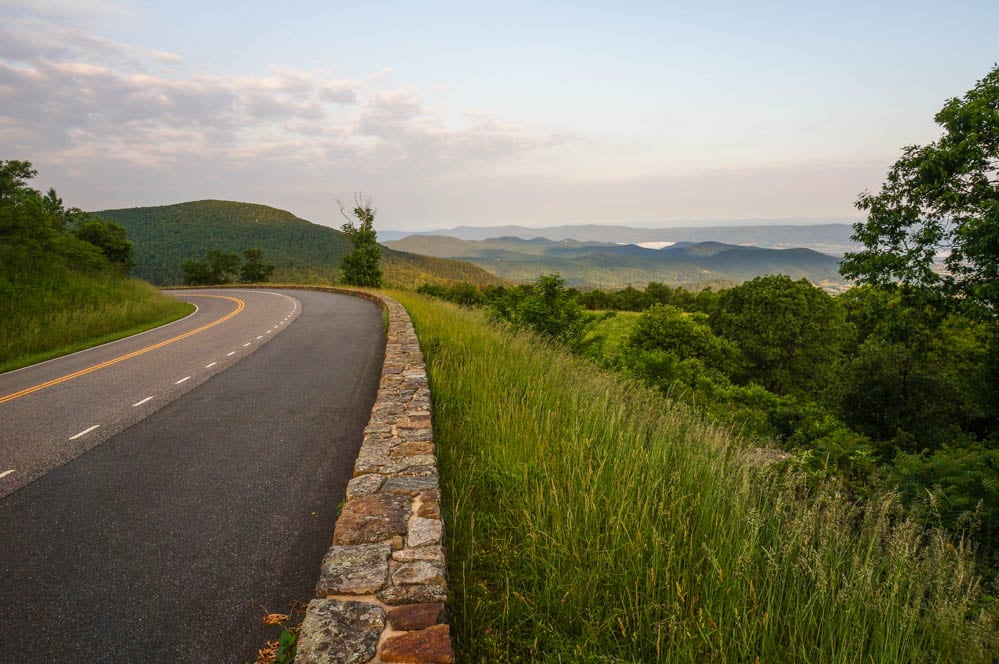
This blog post about driving Skyline Drive in Shenandoah National Park contains affiliate links. If you click on one of those links and make a purchase from one of our partners, we may earn a commission, without any extra cost to you. This helps support this website and ensures fair compensation for our team.
This is one of the greatest and most visited recreational mountain roads in the United States, a place visited by more than 1.25 million people each year. It’s one of the most scenic drives in America’s national parks.
Blessed with a fantastic location in central Virginia, Skyline Drive is only a couple of hours from Washington, D.C. and Richmond, and just thirty minutes from Charlottesville.
Contents
- Shenandoah National Park Skyline Drive Guide 2024
- Four Skyline Drive Entrances
- Wildlife and Wilderness
- 75 Spectacular Skyline Drive Overlooks
- What to Do on Skyline Drive, Virginia
- Visitor Facilities on Skyline Drive
- Places To Stay In/Near Shenandoah National Park
- Shenandoah Skyline Drive FAQ
- More About Shenandoah National Park
Shenandoah National Park Skyline Drive Guide 2024
You can cover all of Skyline Drive’s 105 miles in just a few hours, but I highly recommend to dedicate at least a full day—but preferably two or more—to exploring this phenomenal mountain road.
Keep in mind, though, that there’s only one (expensive) gas station in Shenandoah National Park, so you’re advised to fill up on fuel before entering the park.
Skyline Drive traverses Shenandoah National Park along the long and narrow crest of the Blue Ridge Mountains. It is the only road through the park, accessible at four different entrances.
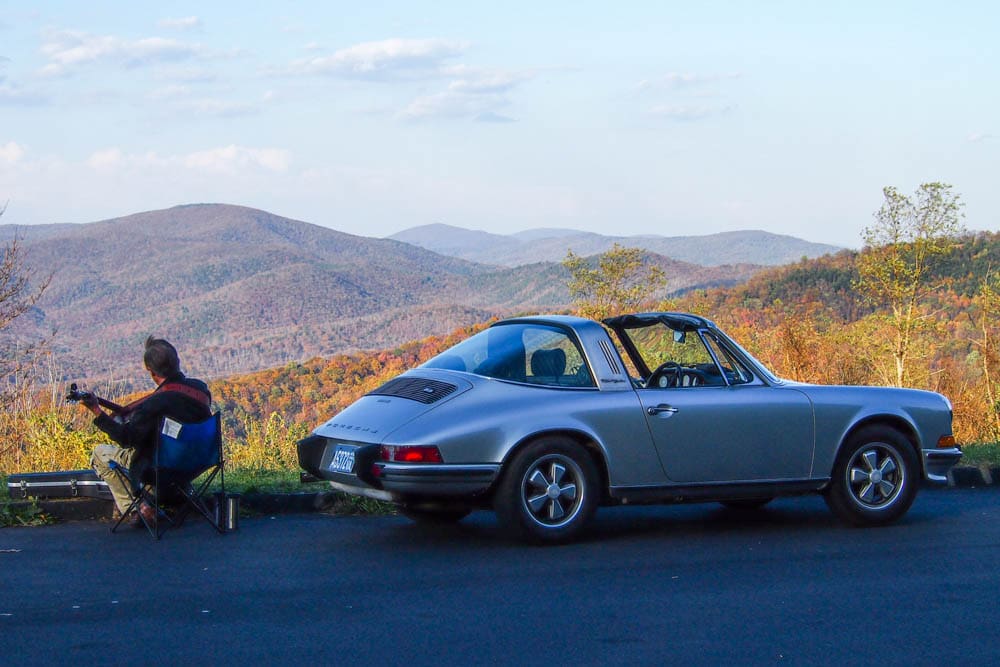
Four Skyline Drive Entrances
The four entrances are spread out throughout the park.
- The northern entrance, the Front Royal Entrance Station is at milepost 0.6 on Skyline Drive and is accessible via Routes 340 and 55. Coming from Washington, D.C., this would be the nearest entrance.
- The Thornton Gap Entrance Station is at milepost 31.5 and can be reached via Route 211.
- At milepost 65.7, you can get to the Swift Run Gap Entrance Station via Route 33.
- The fourth and southern entrance to Shenandoah National Park, the Rockfish Gap Entrance Station lies at milepost 104.9. It is accessible via Interstate 64 and Route 250. This is also where Skyline Drive connects to the Blue Ridge Parkway. It’s the most convenient entry point when coming from Richmond and Charlottesville to the east or from Staunton and the southern Shenandoah Valley to the west.
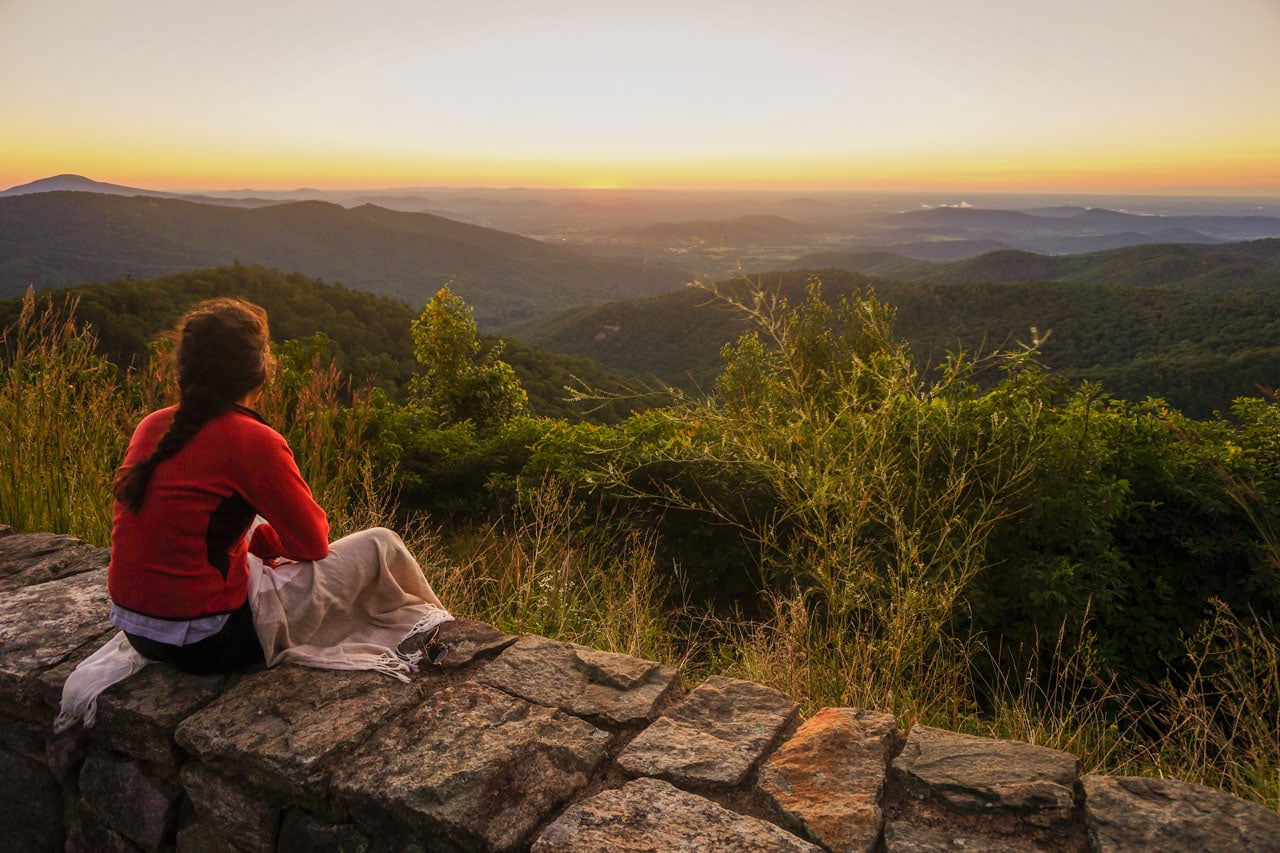
Wildlife and Wilderness
While Shenandoah National Park is sometimes regarded as more of a tourist attraction than a nature preserve, it actually has one of the highest percentages of wilderness areas of all U.S. national parks.
No less than 40% of Shenandoah National Park’s surface area is federally designated wilderness.
Even though the park’s landscapes might not be as spectacular as those in some of the West Coast parks, it encompasses some seriously wild terrain.
Shenandoah National Park consists primarily of forest-covered hills and mountains—95% of the park is forest. Valleys both wide and narrow characterize the landscape as well, cut out by mountain streams and waterfalls.
Plant diversity is enormous. More than 1,400 vascular plants, including no fewer than 132 species of trees (more than all of Western Europe combined), and 1,650 non-vascular plants, such as mosses and lichens, contribute to the park’s impressive biodiversity.
All these trees create a spectacularly colorful show in the fall. Read this blog post to discover the greatest Skyline Drive viewpoints for fall colors!
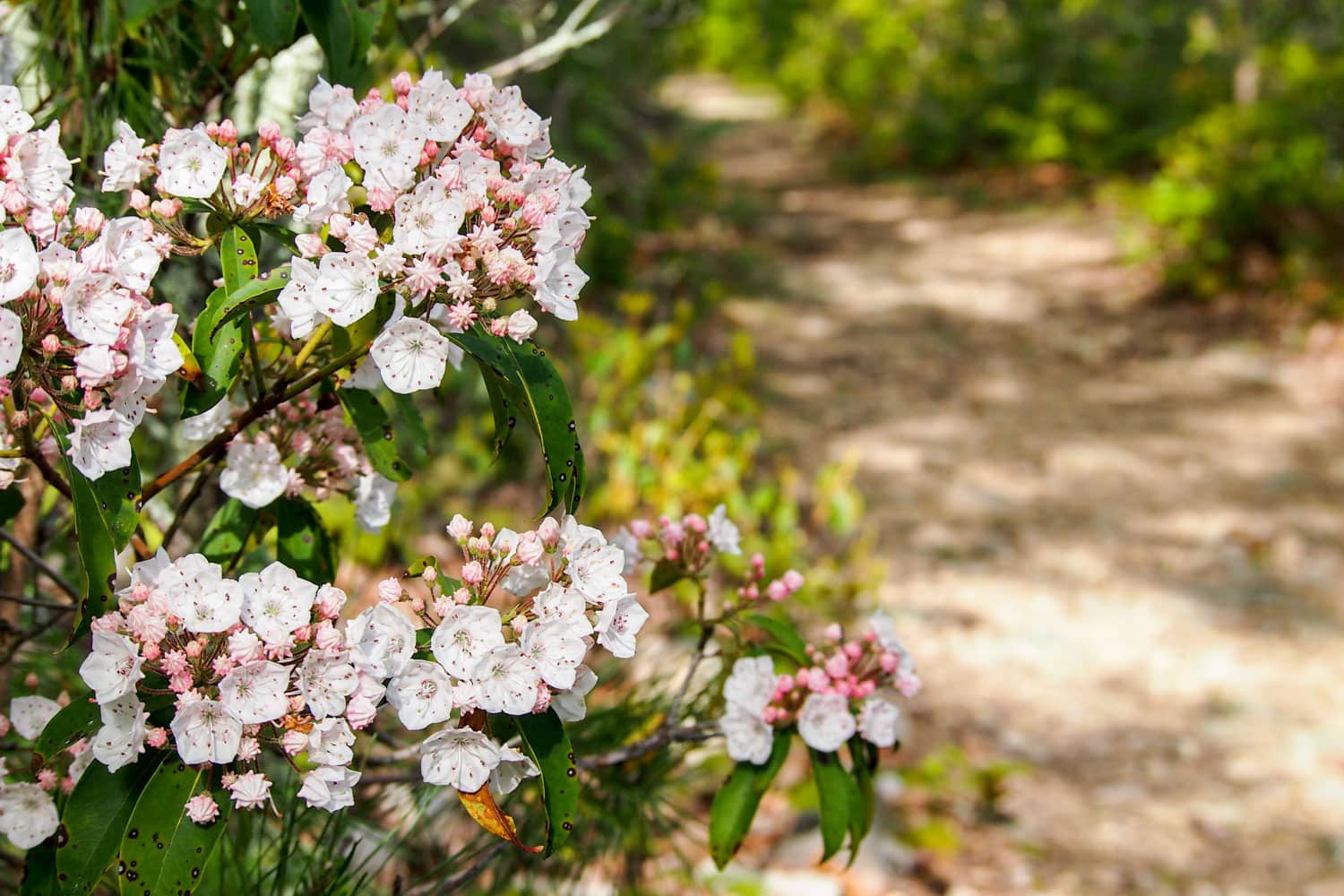
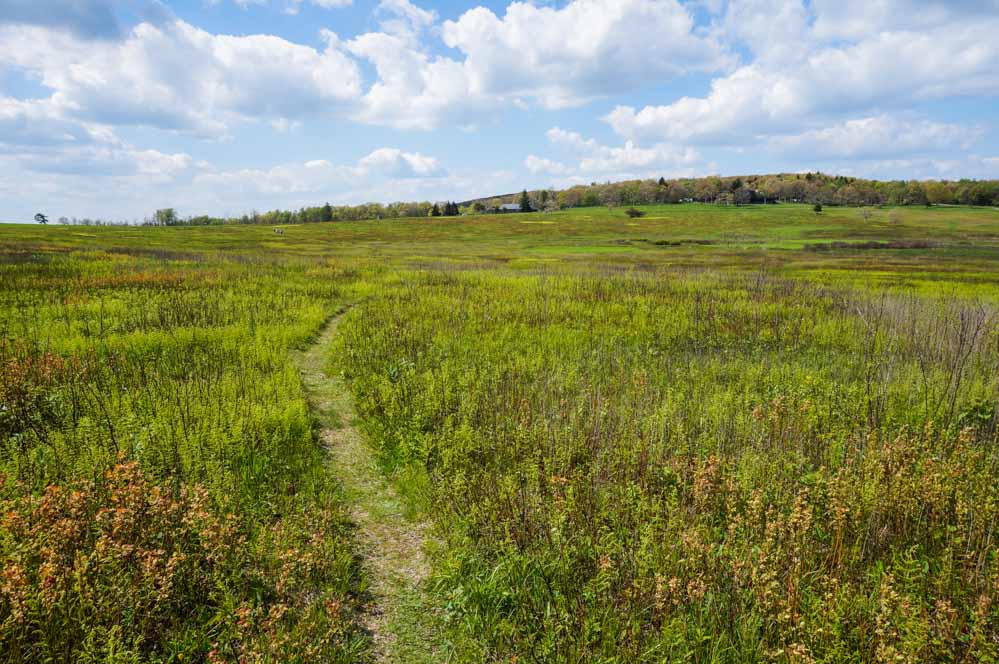
This verdant environment provides the perfect habitat to a wide variety of wildlife.
Nearly 40 fish species thrive in Shenandoah National Park’s ponds, rivers and streams, while some 53 mammals roam its woodlands. Additionally, you can spot up to 200 different species of birds and 26 reptiles, including 18 snake species.
Clearly, this is a hotspot of biodiversity. And the beauty of it all is that you don’t necessarily have to leave your car to enjoy it.
Often, you’ll spot wild animals in Shenandoah National Park while driving Skyline Drive, at your campsite or even while enjoying a bite or beverage at one of Shenandoah’s lodges.
The most common sightings are white-tailed deer, black bears, wild turkeys, groundhogs, and chipmunks. Fortunate visitors might occasionally spot golden eagles, bobcats, and skunks as well. It’s one of the greatest places in Virginia for nature photography.
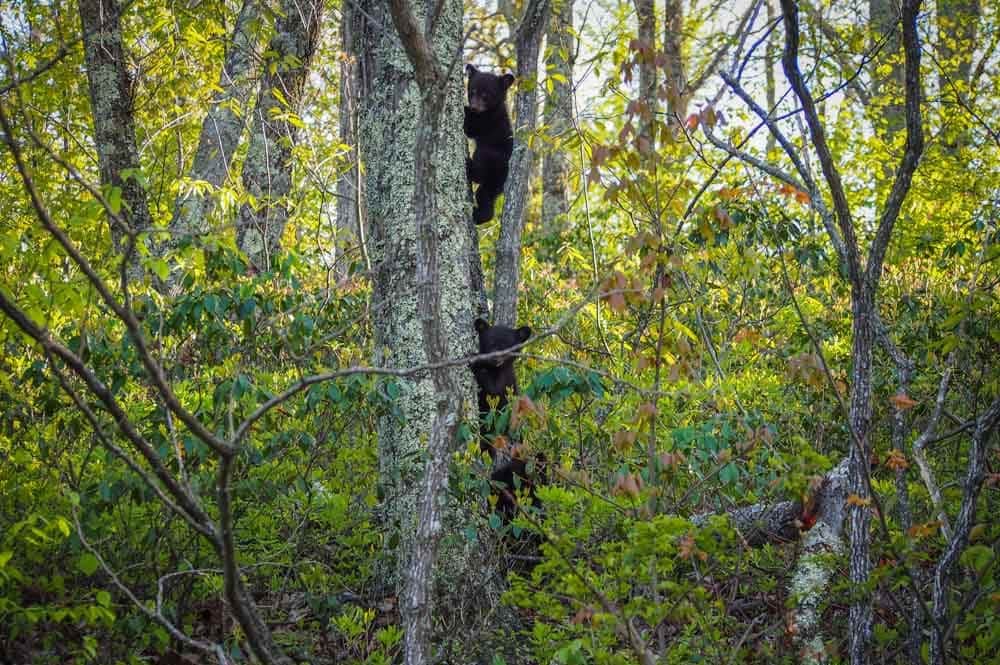
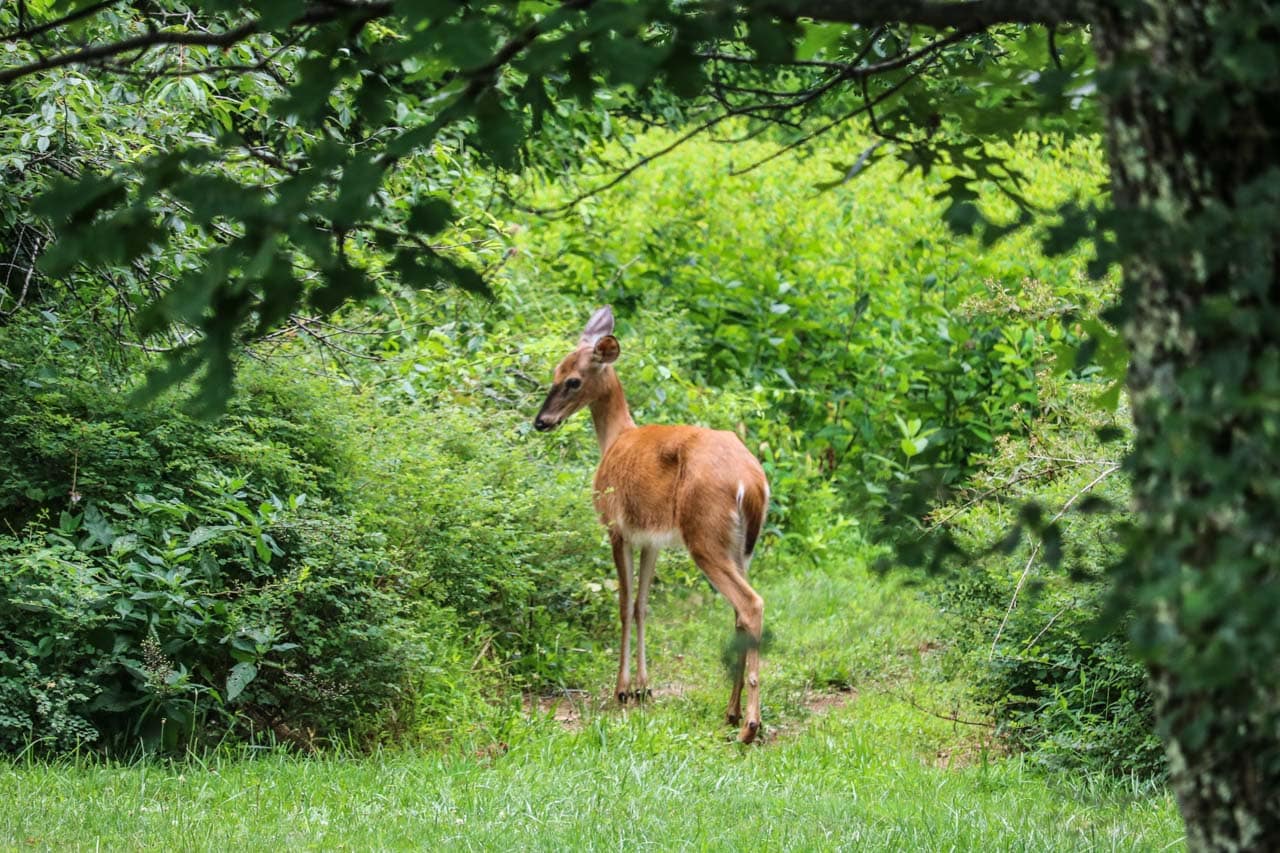
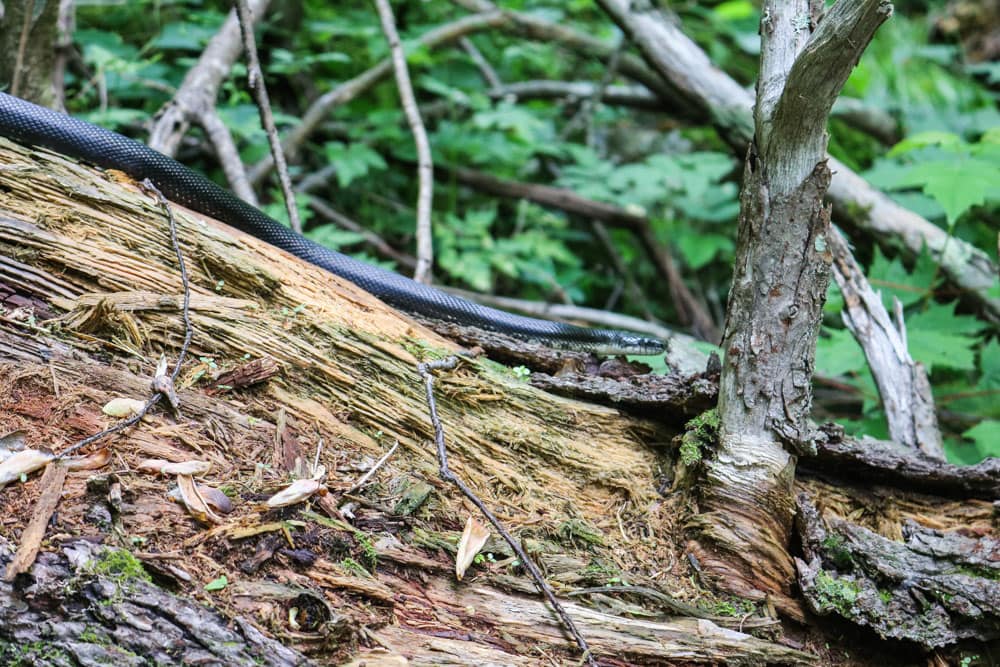
75 Spectacular Skyline Drive Overlooks
There are no fewer than 75 overlooks on Skyline Drive’s 105 miles. In other words, you can enjoy a great view every 1.5 miles on average.
Check out the absolute best overlooks and viewpoints in Shenandoah National Park here.
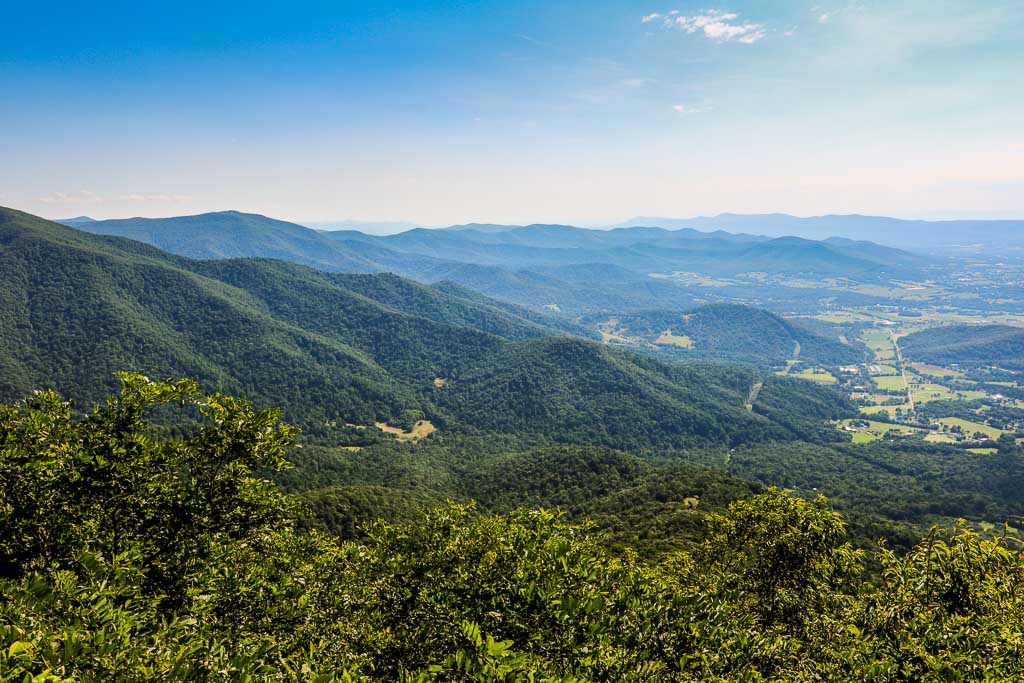
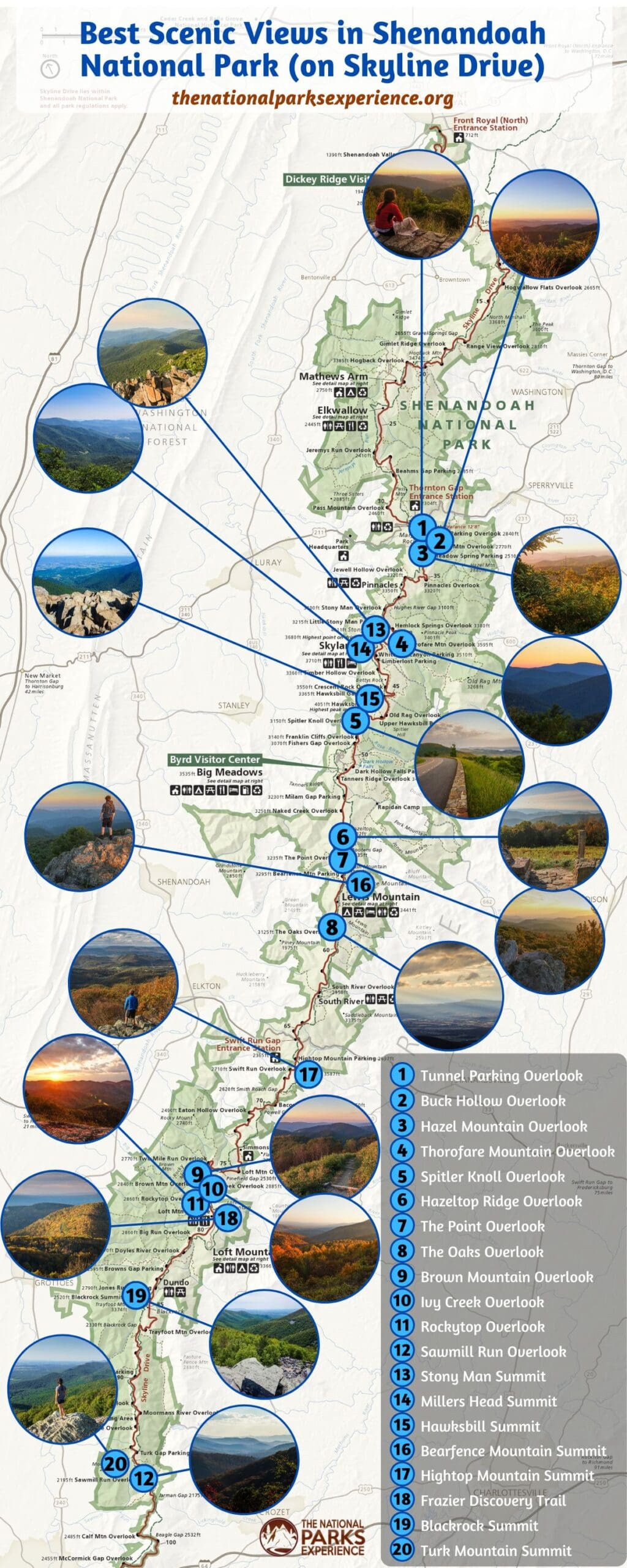
What to Do on Skyline Drive, Virginia
Hike a Section of the Appalachian Trail
Shenandoah National Park has 516 miles of hiking trails, 101 miles of which are on the iconic Appalachian Trail.
This long-distance trail, running from Georgia all the way to Maine, roughly follows Skyline Drive and can be accessed at numerous points along the road.
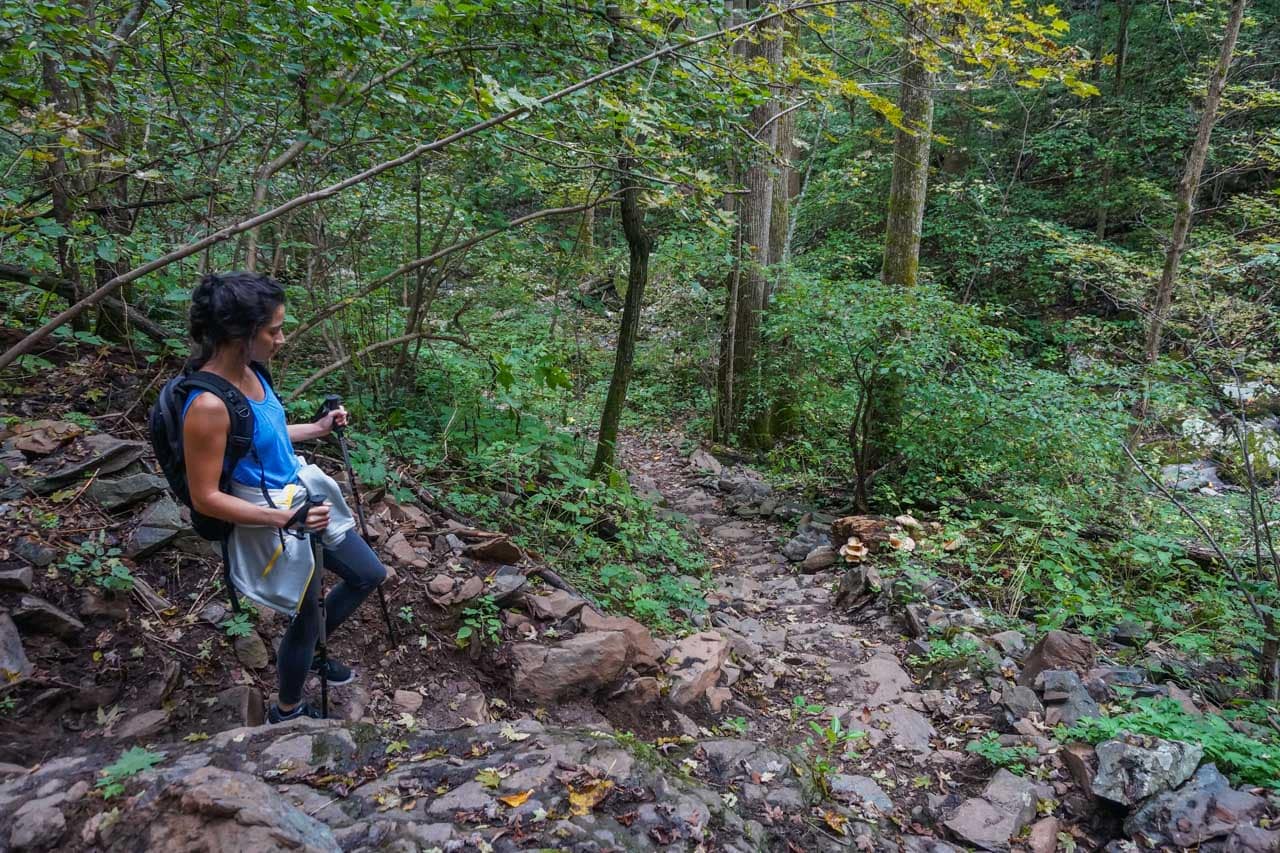
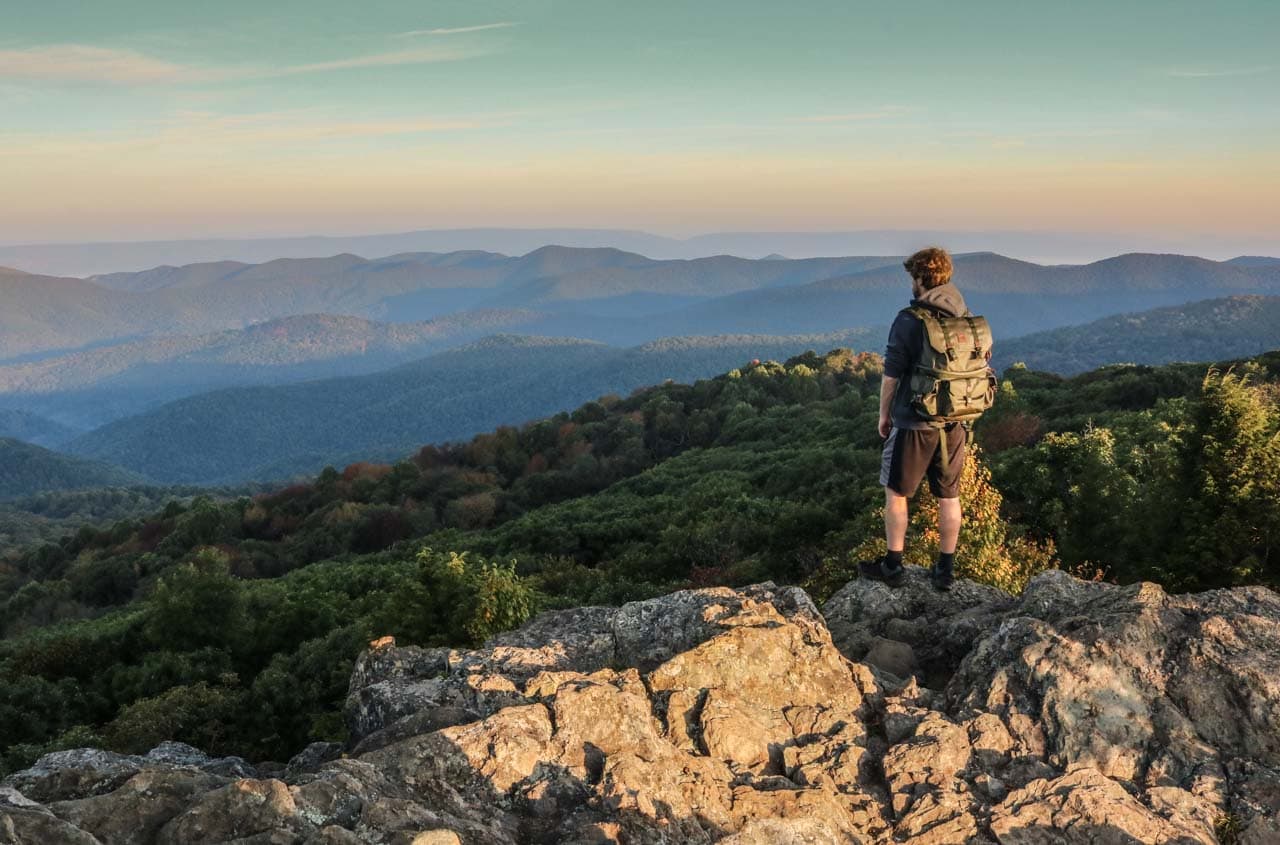
Visit Big Meadows and the Byrd Visitor Center
One of the most remarkable Skyline Drive attractions, Big Meadows lies in the heart of the national park. Previously used as farmland, although its exact origins remain unclear, this huge grassland area is now artificially kept clear through controlled fires and mowing.
This allows for an abundance of wildflowers, grasses and herbs to flourish, which in turn attract wildlife such as butterflies, birds, white-tailed deer and black bears.
The Harry F. Byrd Visitor Center is directly across the road from Big Meadows. There, you can learn about the park’s creation and history. Definitely make sure to check out the exhibit “Within a Day’s Drive of Millions.”
Besides the exhibits, there are restrooms, a bookstore, information desks and ranger programs.
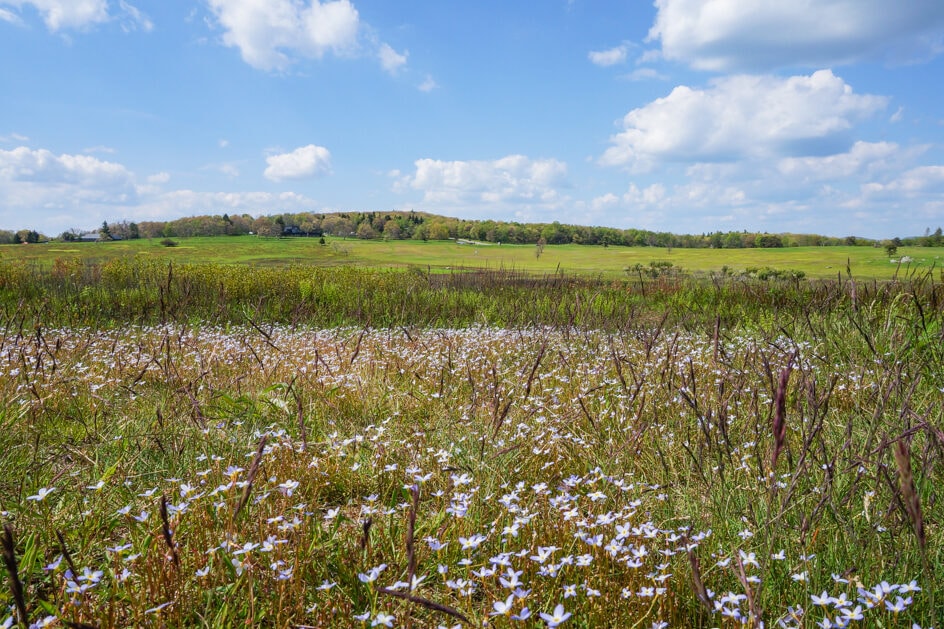
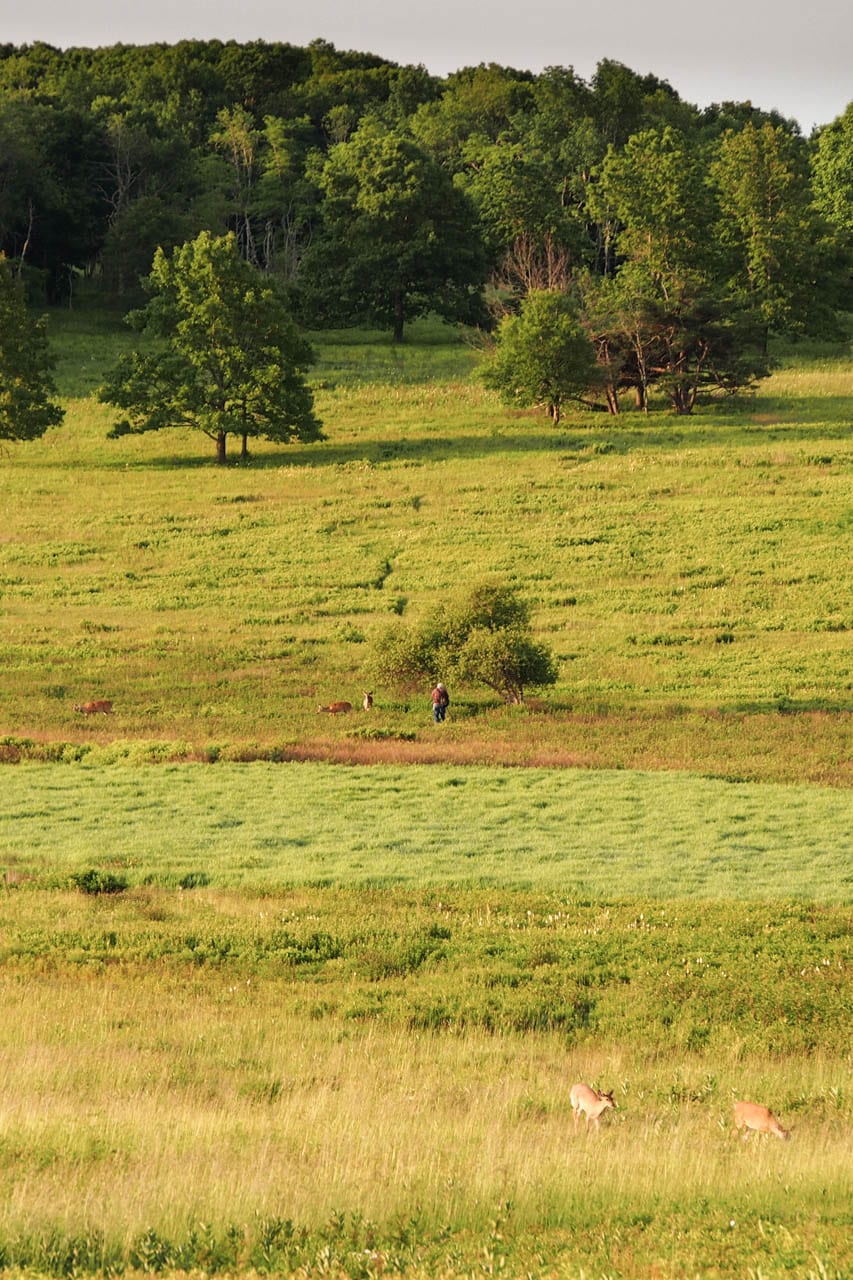
Climb a Mountain Summit
Of the many hiking trails in Shenandoah National Park and on Skyline Drive, several lead to panoramic views atop a barren summit. Some are fun rock scrambles.
These summit hikes and rock scrambles are extremely fun things to do along Skyline Drive in Shenandoah National Park.
Suggested mountain summits to climb are Bearfence Mountain, Blackrock Summit, Hawksbill Summit, Stony Man and Turk Mountain.
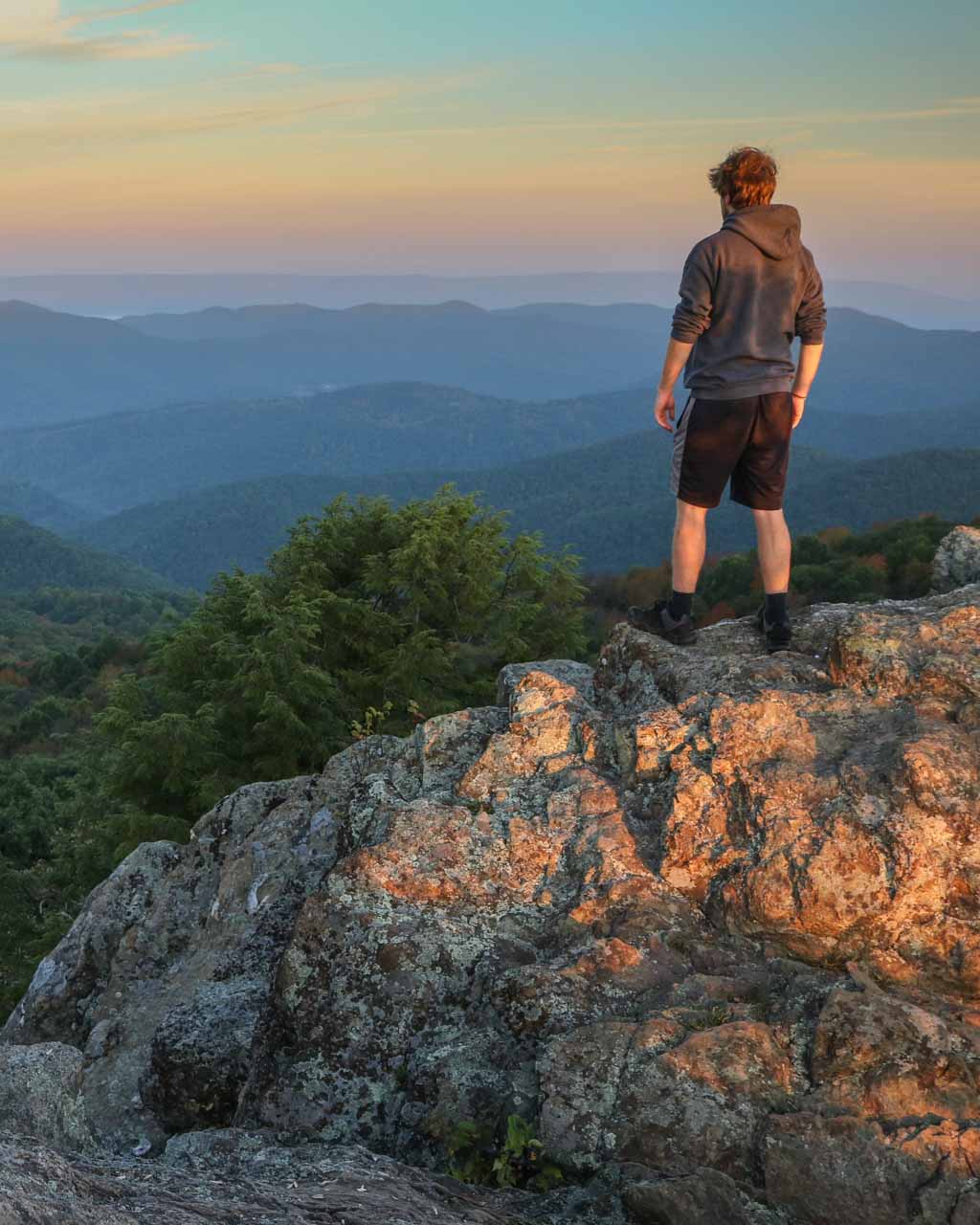
Explore Backcountry Wilderness
Other trails run deep into Shenandoah National Park’s wilderness areas, places where it’s common to spot deer and bears. I personally loved the loop hike created by connecting the Trayfoot Mountain and Paine Run Trails.
For an epic backpacking trip in Shenandoah, you can hike the 100+ miles of the Appalachian Trail that run through the park.
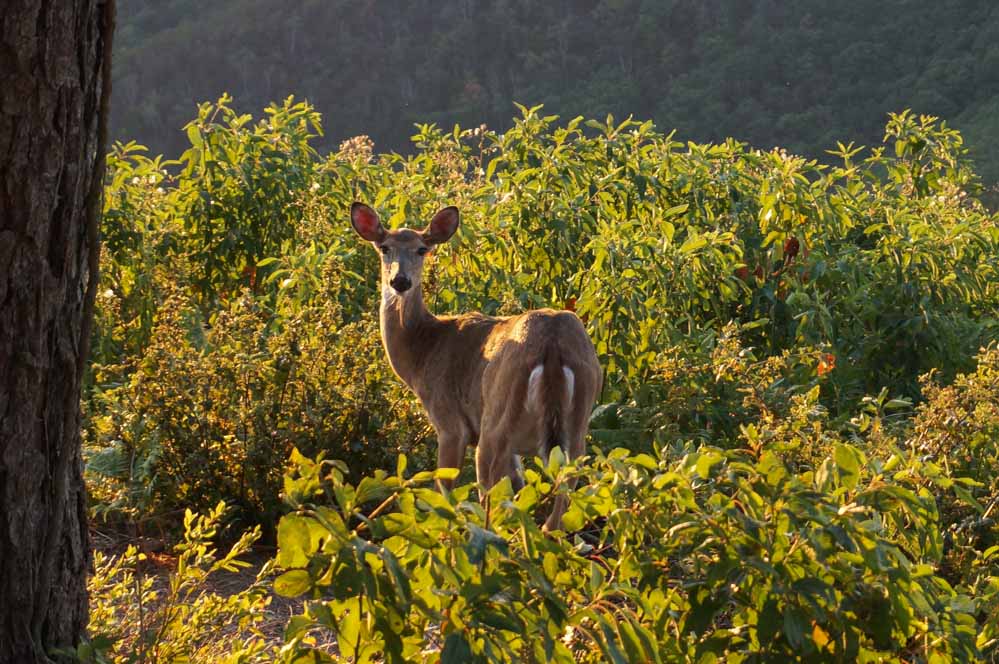
See Beautiful Waterfalls
In addition to mountain summits and wilderness, several trails also take you to spectacular waterfalls.
I strongly recommend doing at least one waterfall hike in Shenandoah National Park when driving Skyline Drive. The easiest and most popular one is the Dark Hollow Falls Trail, just north of Big Meadows.
Other superb waterfall hikes are Overall Run Falls, Whiteoak Canyon, South River Falls, Doyles River Falls and Jones Run Falls, and Rose River Falls.
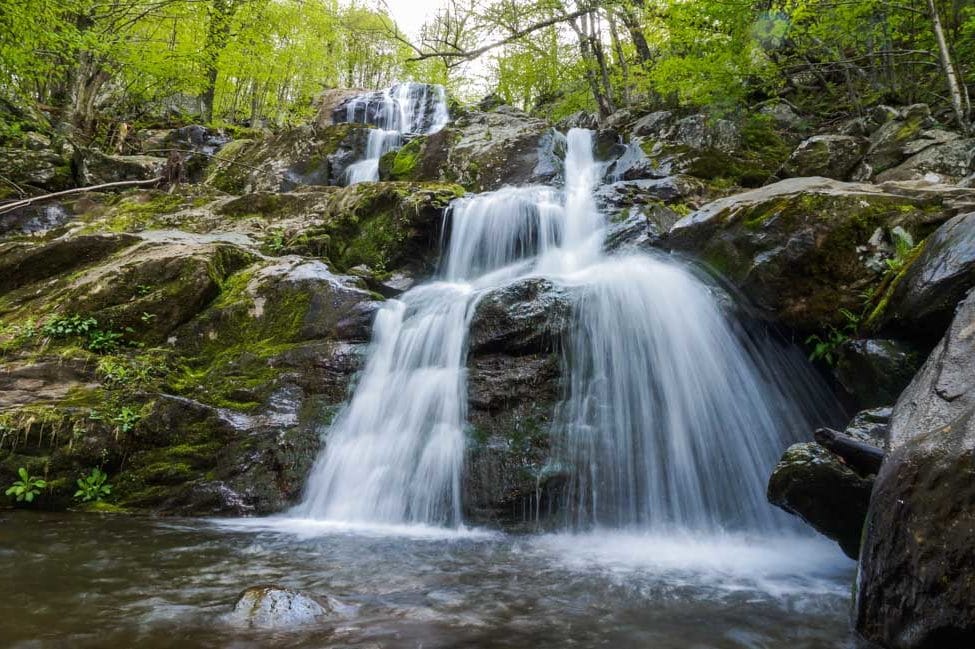
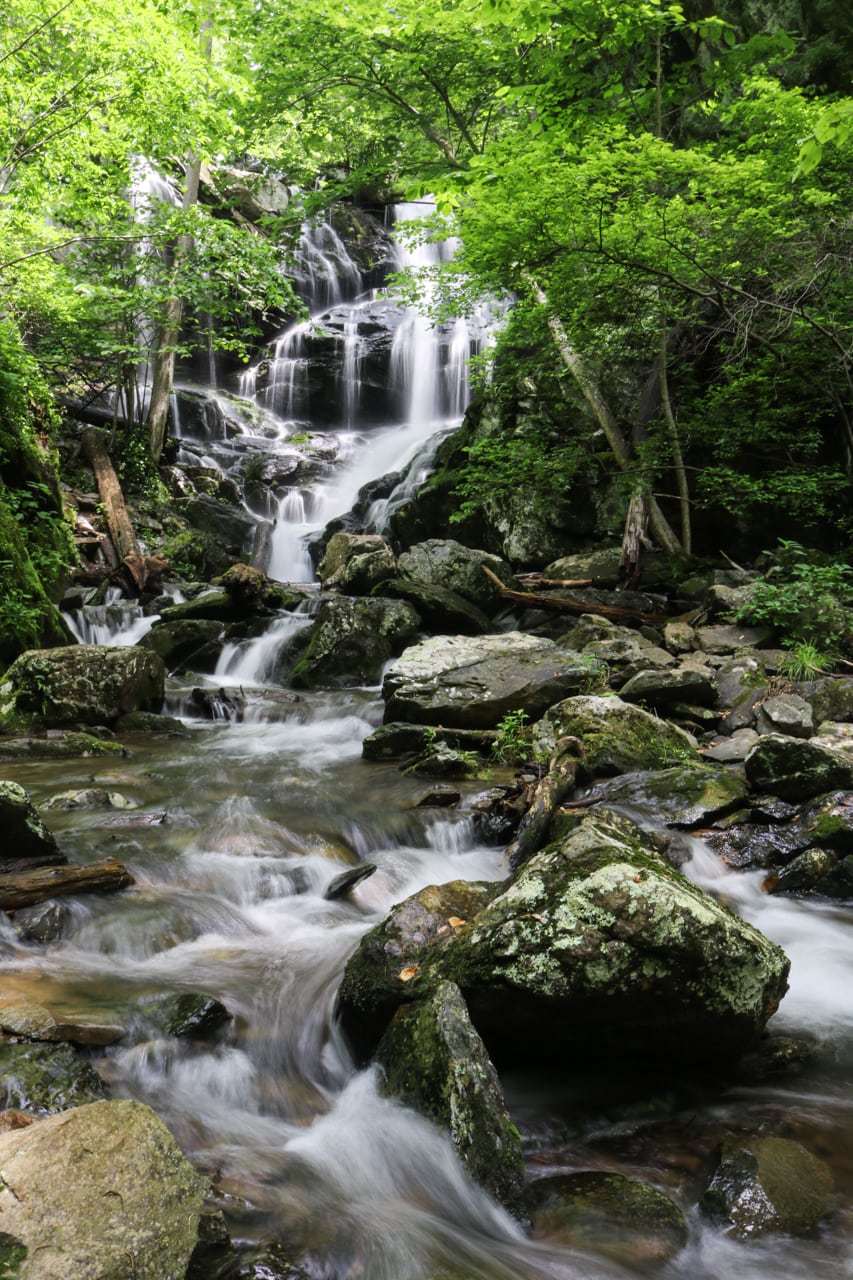
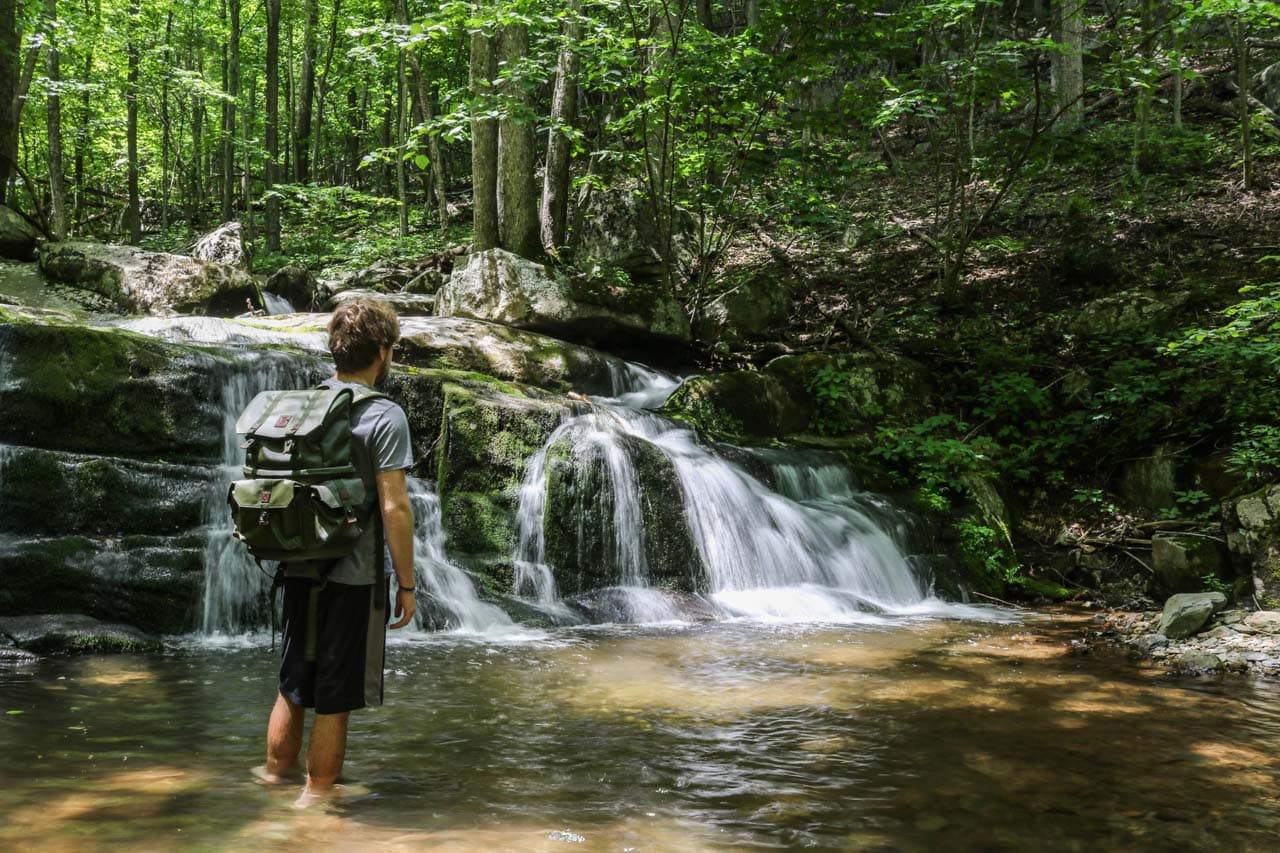
Enjoy a Sunrise and/or Sunset on Skyline Drive
One of my favorite things to do in Shenandoah National Park is watching sunrises and sunsets from Skyline Drive.
From the many overlooks and mountaintops, the landscapes are heart-achingly beautiful in the “golden hour.” This really should be a priority during your visit to the park and Skyline Drive.
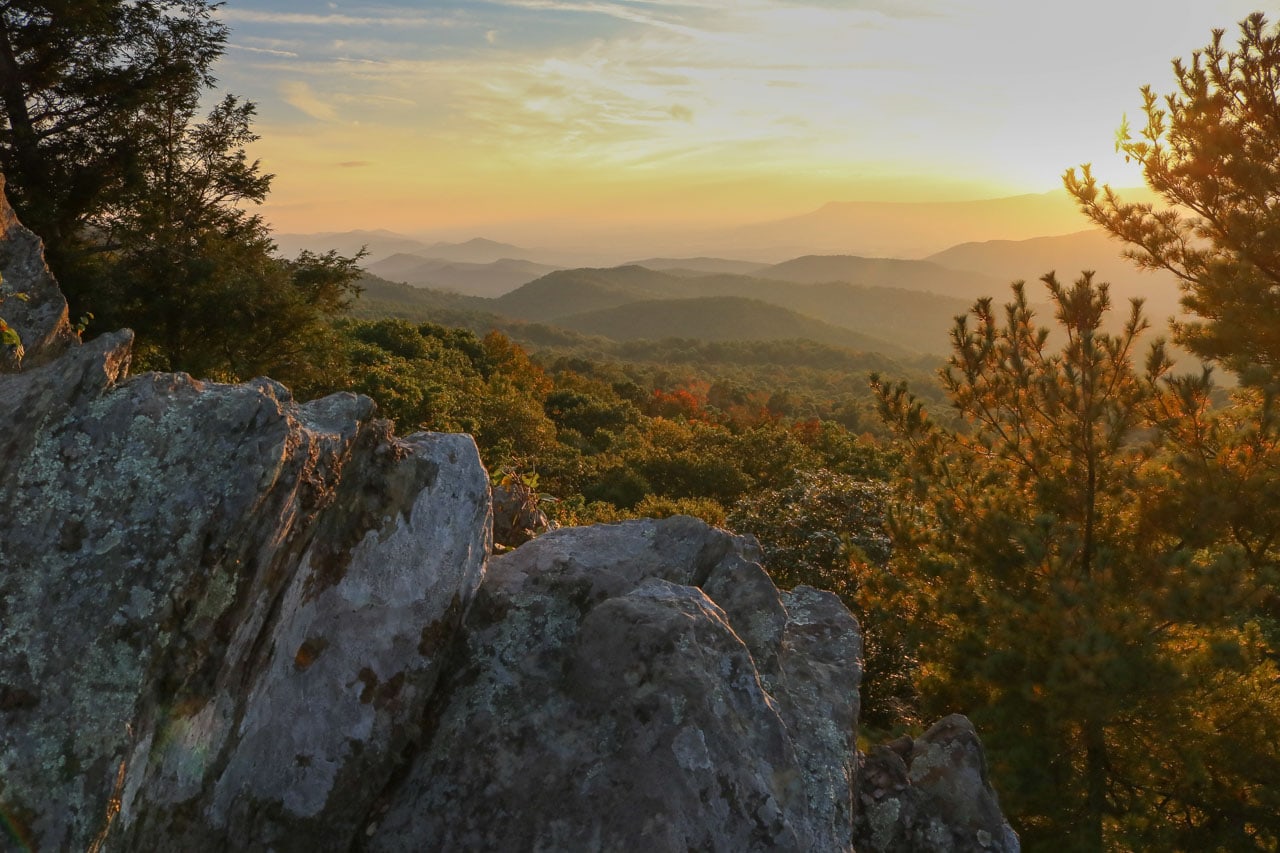
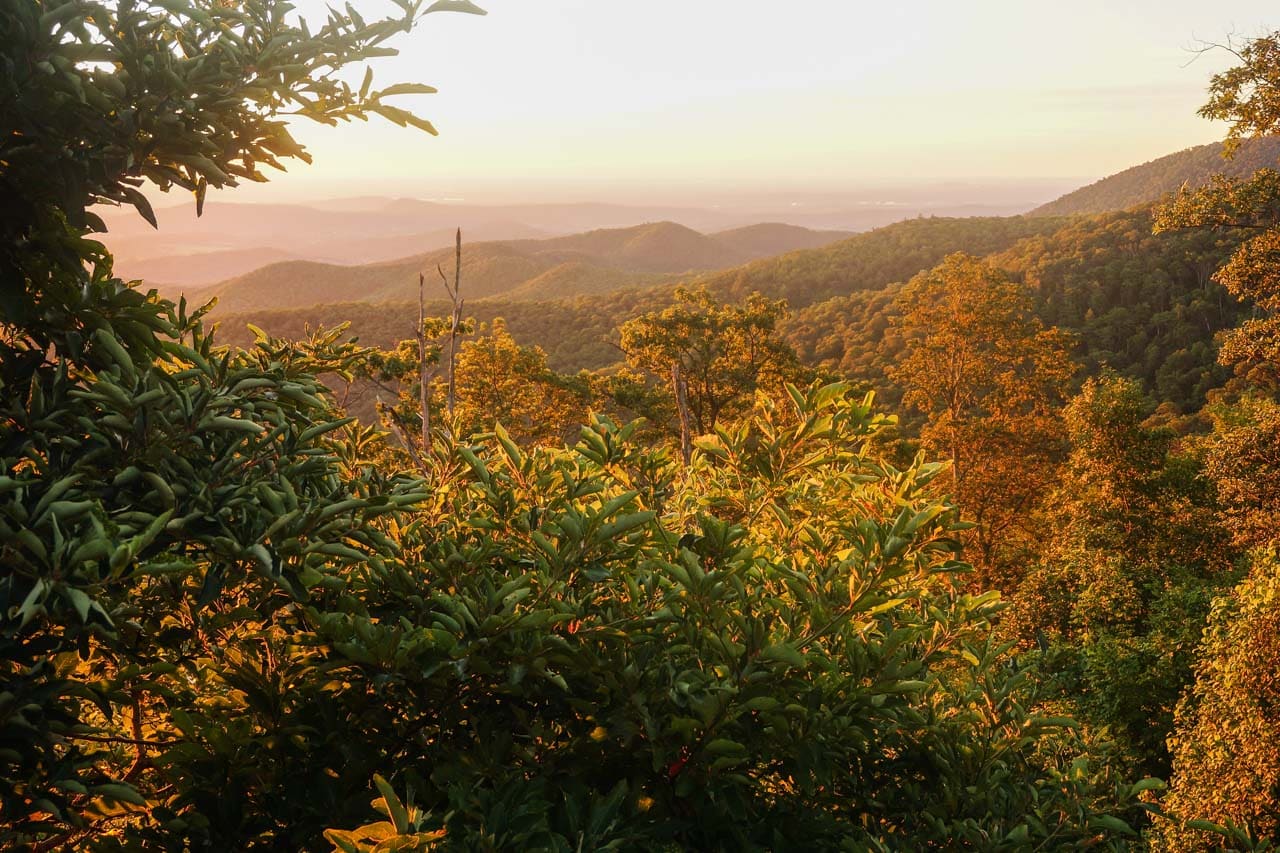
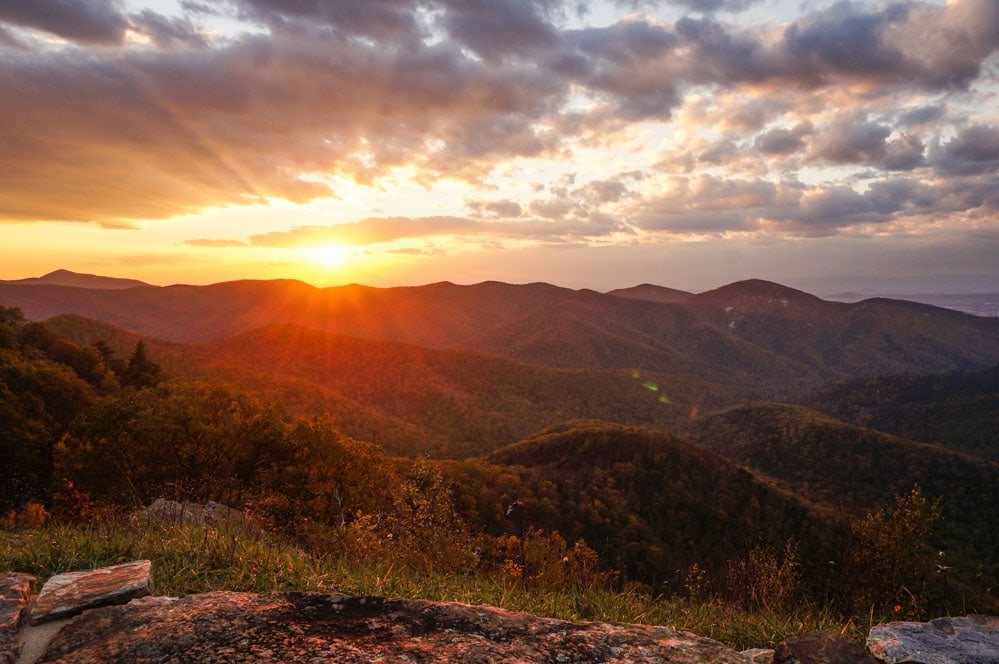
Visitor Facilities on Skyline Drive
Along Skyline Drive, there are:
- Two visitor centers (the Dickey Ridge Visitor Center at milepost 5 and the Harry F. Byrd Visitor Center at milepost 51)
- Four campgrounds (Matthews Arm at milepost 22, Big Meadows at milepost 51, Lewis Mountain at milepost 57.5 and Loft Mountain at milepost 79.5). Basic overnight facilities off of Skyline Drive include eight Appalachian Trail huts and six backcountry cabins.
- Three accommodations (Skyland Resort at milepost 41, Big Meadows Lodge at milepost 51 and Lewis Mountain Cabins at milepost 57.5)
- Three waysides (Elkwallow Wayside at milepost 24, Big Meadows Wayside at milepost 51 and Loft Mountain Wayside at milepost 79.5) selling everything from snacks and sandwiches to camping supplies and gifts.
- One gas station (Big Meadows at milepost 51)
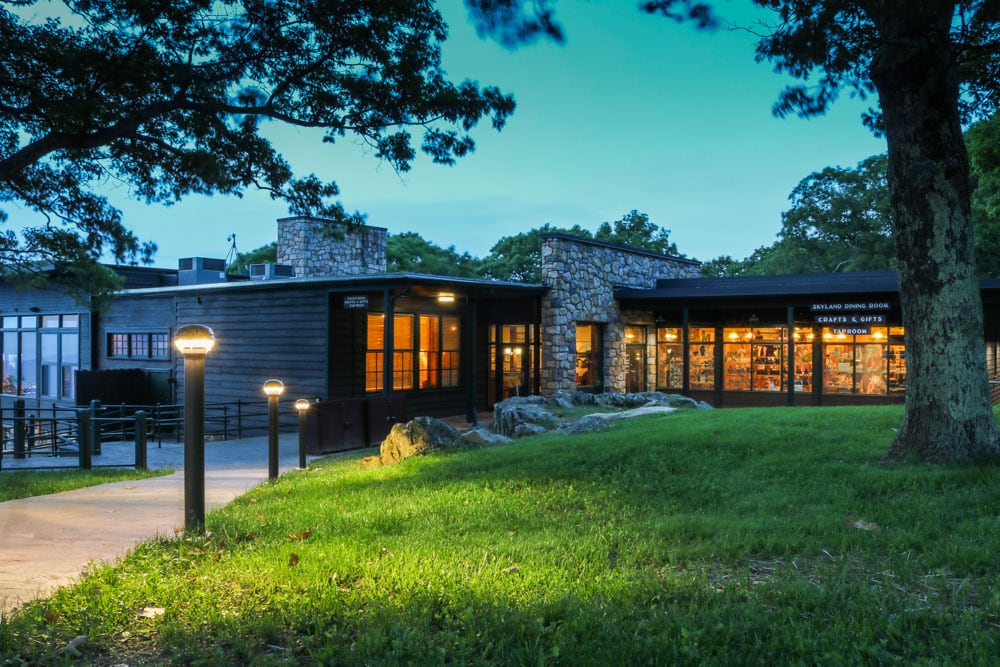
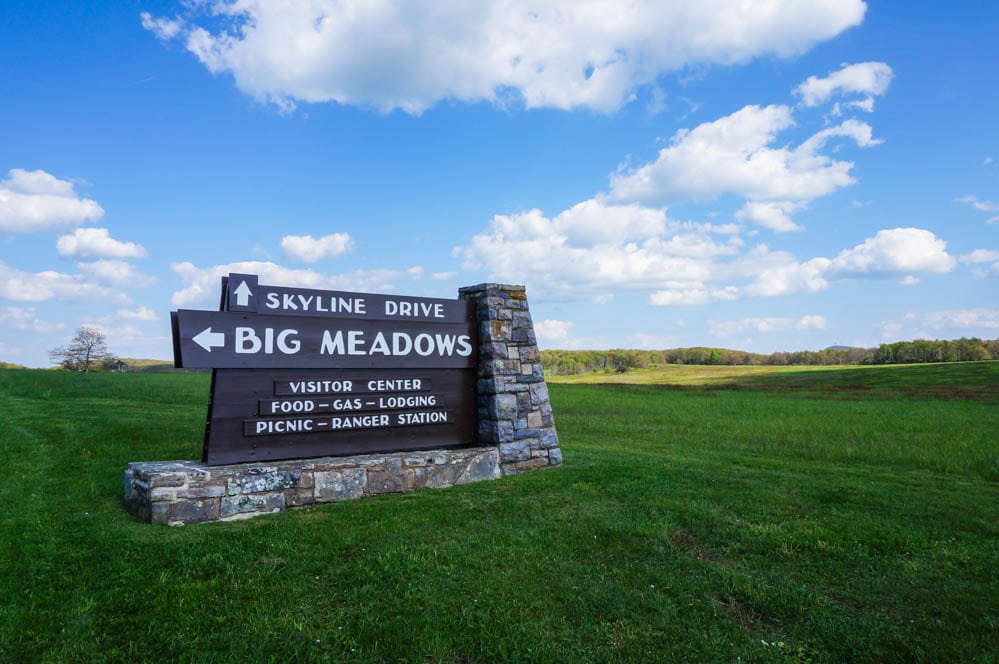
Places To Stay In/Near Shenandoah National Park
There are several Skyline Drive campgrounds in the park, as well as two historic lodges and a collection of fun cabins. Check out Go Shenandoah if you’re looking for Skyline Drive lodging and would like to stay at one of the amazing and well-located lodges.
For accommodation in towns around Shenandoah National Park, consider staying in Harrisonburg or Charlottesville.
Shenandoah Skyline Drive FAQ
In this section, I’ll briefly answer some of the most frequently asked questions about Skyline Drive in Shenandoah National Park, Virginia.
If you have any other questions, most of them will be answered elsewhere in this post. Additionally, you’ll also find a wealth of information on the National Park Service website.
Where Is Skyline Drive?
This scenic national park road runs through the heart of Shenandoah National Park in central Virginia.
It’s the only public road in the park, offering access to numerous trailheads, overlooks and other points of interest. It’s only 70 miles west from downtown Washington, D.C. and 92 miles west from Richmond, Virginia.
How Long Is Skyline Drive?
The total length of Skyline Drive, from the northern to the southern entrance station, is 105 miles.
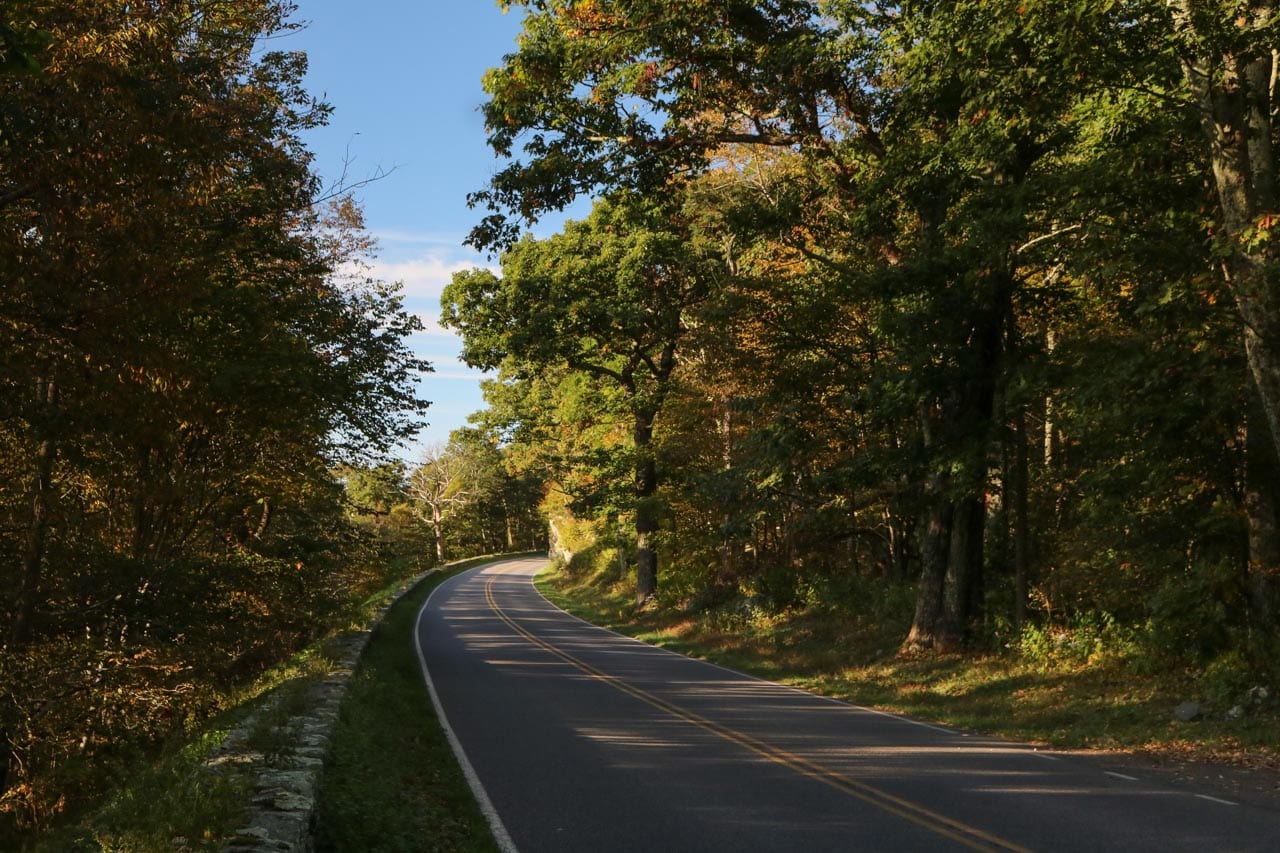
How Long Does It Take to Drive Skyline Drive?
The speed limit on Skyline Drive is 35 mph, which means that you can cover its 105 miles in just 3 hours without stopping. However, it’s the countless stops that make this such an amazing road to drive.
Count on 5-6 hours or more to really get the most out of driving Skyline Drive. This would include a short hike, a visit to a visitor center and several stops at scenic overlooks.
While you can rush through Shenandoah National Park in one morning or half a day, I do recommend dedicating at least one full day to exploring this beautiful park.
Where Can I Enter Skyline Drive?
There are four different entrances, located at regular intervals along the road. From north to south:
- Front Royal – mile 0.6, accessible via Routes 340 and 55
- Thornton Gap – mile 31.5, accessible via Route 211
- Swift Run Gap – mile 65.7, accessible via Route 33
- Rockfish Gap – mile 104.9, accessible via Route 350 and I-64 (this is also the northern terminus of the Blue Ridge Parkway)
What Are the Skyline Drive Hours?
Depending on weather conditions, Skyline Drive is open to vehicles 24/7. The vast majority of closures occur in winter, when ice and snow can make driving impossible.
Note that even when the road is closed to vehicles, you can still enter the park on foot at all four entrances.
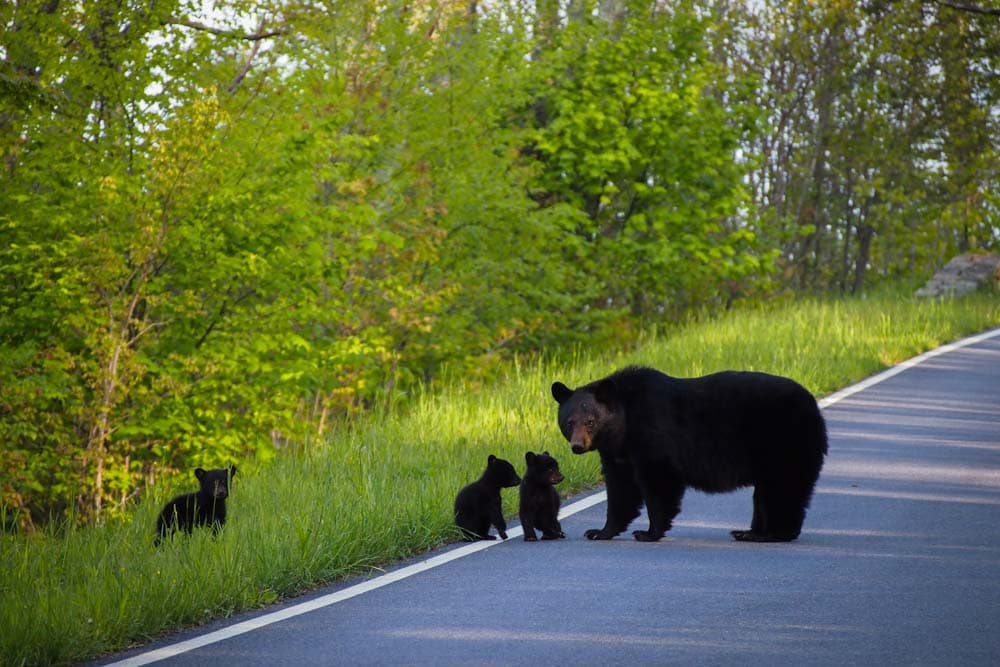
What Is the Skyline Drive Cost?
Like most U.S. national parks, Shenandoah National Park has an entrance fee. In 2021, the difference Skyline Drive entrance fees are as follows:
- Single vehicle: $30
- Single motorcycle: $25
- Individual hiker or cyclist: $15
All entrances fees are valid for seven consecutive days starting on the date of purchase. You may leave and re-enter the park as often as you like in that period.
If you’re planning on driving Skyline Drive and visiting Shenandoah National Park more than once in a single year, it’s worth buying an annual pass.
- Shenandoah annual pass: $55 (year-long access to Shenandoah National Park)
- America the Beautiful Pass: $80 (year-long access to all National Park Service sites and other federal recreation sites) – HIGHLY RECOMMENDED!
What Part of Skyline Drive Is Best?
I personally think that the entire road is fantastic. However, if I had to pick a certain section, I’d choose the stretch between the Thornton Gap and Swift Run Gap entrances, the Central District.
That’s where you’ll find most of the best waterfall hikes in Shenandoah National Park, as well as both Skyland and Big Meadows Lodge, and most of the park’s best sunrise and sunset spots.
This section has the most visitor facilities overall, including the park’s only gas station.
What Is the Best Time to Drive Skyline Drive?
Except for temporary weather-related closures in winter, Skyline Drive is open all year.
And the views are spectacular at any time, whether it’s on a frosty day in winter, a foggy evening in spring, a sun-soaked summer afternoon or crisp morning in fall.
Late-spring through fall is the busy season on Skyline Drive, with the absolute peak in visitation occurring in fall. Even though fall is quite busy in Shenandoah National Park, I do recommend visiting that time of year if you can. The fall foliage throughout the park is glorious.
Here are a handful of amazing fall hikes you can do in Shenandoah National Park, all of which start on Skyline Drive.
Spring, on the other hand, is beautiful as well, as the forest reawakes after winter, mountain laurel blooms and wildlife is super-active.
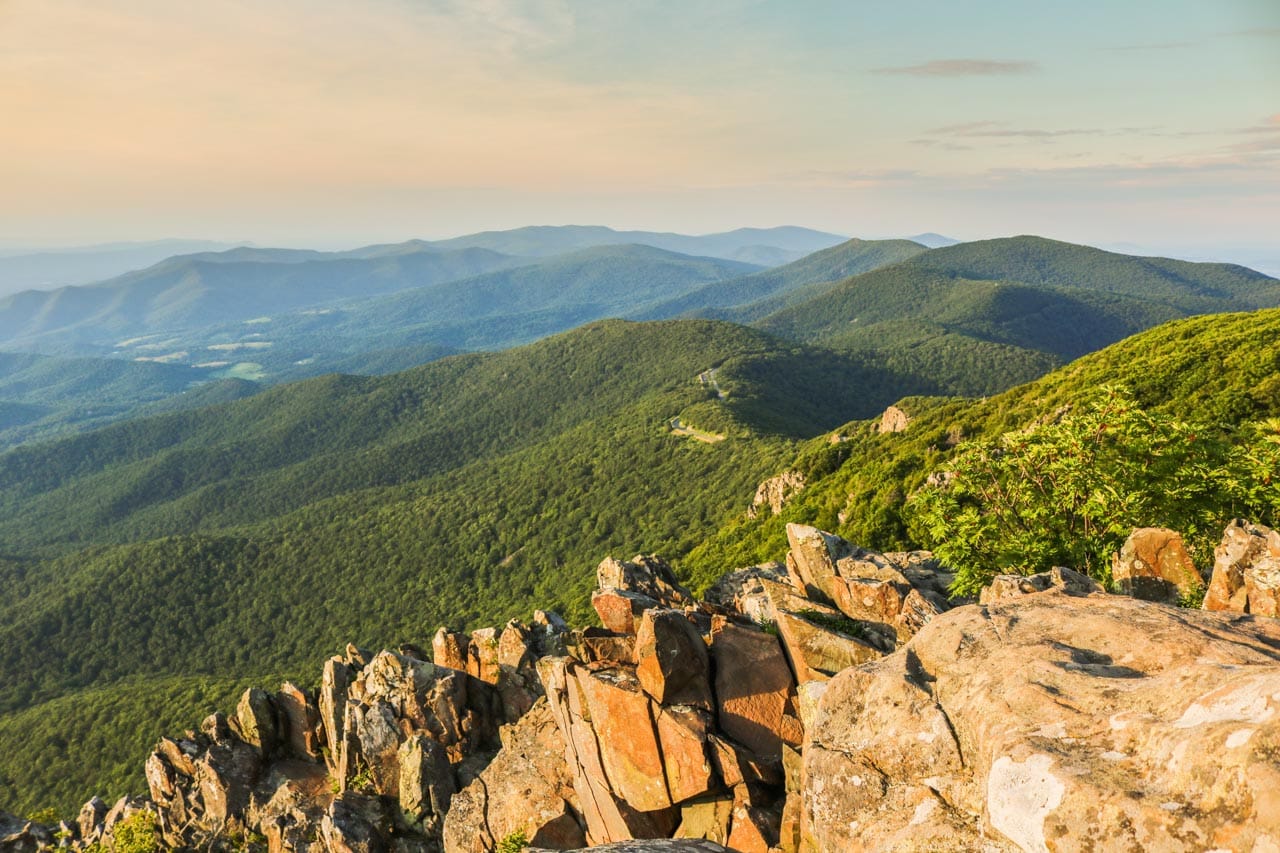
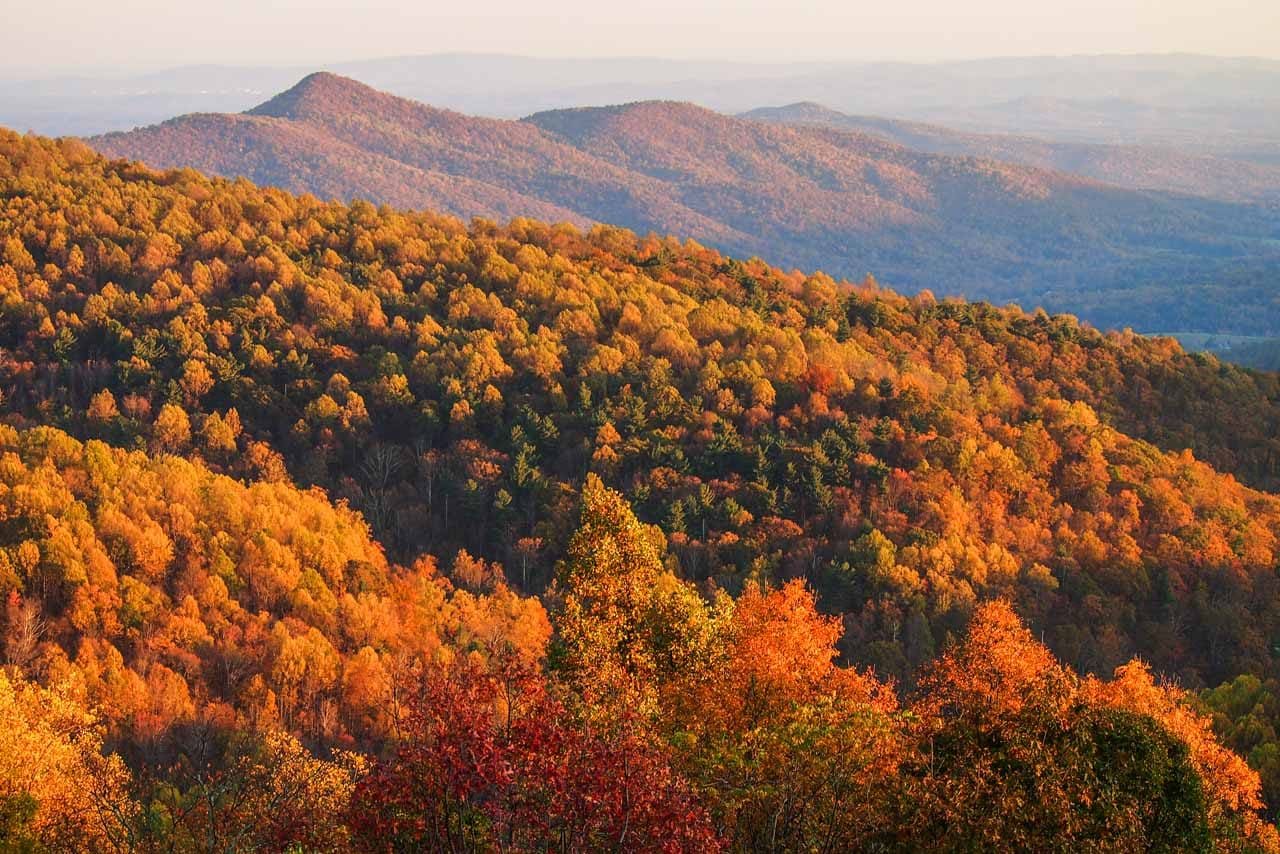
More About Shenandoah National Park
- Park Website
- Travel Guide
- Topographic Map
- Best Shenandoah Hikes
- Top Things To Do in Shenandoah National Park
- Where to See Wildlife in Shenandoah National Park
- Best Views in Shenandoah
- Fall Foliage Viewing on Skyline Drive
- Accommodation

Steve
Wednesday 8th of May 2019
When is the best time to visit, fall or spring? I realize that will be an opinion but what do most people say?
Bram Reusen
Friday 10th of May 2019
That's tough one, Steve. Spring is delightful with all its fresh greenery, wildflowers, bear cubs and other wildlife, while fall has the glorious fall colors. Personally, I prefer spring in Shenandoah!